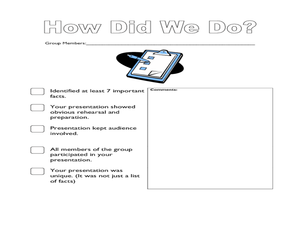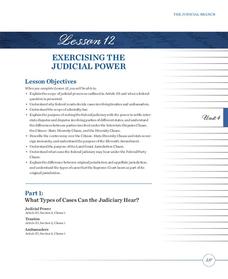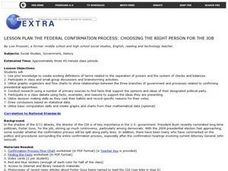Curated OER
Civics: State Vs. Rowe
Students examine the case of State vs. Rowe to discover the duties of the three branches of government. They explore the concepts of separation of powers and checks and balances to assess how they apply to an actual situation.
Ohio Center For Law-Related Education
Four Activities: Thurgood Marshall and the Nomination and Confirmation of Federal Judges
The process of nominating and confirming federal judges can sound like a lot of bureaucratic hoops, but a resource breaks down the steps of the Supreme Court nominations in a simpler manner. Learners participate in four activities that...
C-SPAN
Presidential Veto and Congressional Override
One of the key powers of the executive branch is the president's ability to pass or veto legislation proposed by Congress. Congress, the legislative branch, on the other hand, can override a president's veto. Five film clips show how the...
James Madison Memorial Fellowship Foundation
A Picture is Worth a Thousand Words
This exercise on the Constitution requires small groups to design a visual metaphor that expresses the concept behind one of seven principles: popular sovereignty, federalism, republicanism, separation of powers, checks and balances,...
Nemours KidsHealth
Food Labels: Grades 9-12
Check the label! That's the big idea in a lesson about using the nutrition facts on food labels rather than advertising hype to make healthy choices about what to eat. After reading background articles and learning how to read nutrition...
Curated OER
Branches of US Government
Students research the responsibilities of the legislative, executive, and judicial branches. In this U.S. government lesson, students research the jobs of those in each branch and present their finding to their classmates.
Curated OER
The 7 "Hats" of the President
Students explore the responsibilities of the President. In this U.S. government lesson, students examine the provided sources related to the President' s roles as Chief of State, Chief Executive, Chief Jurist, Chief Diplomat, Chief...
Curated OER
Separation of Powers
Students compare the role of federal and local government. In this government lesson, students watch "Separation of Powers." Students discuss the federal and state powers prior to participating in a simulation that requires them to...
Curated OER
Claim Your Power
Fourth graders analyze the branches of the Texas government and identify its powers and characteristics. The separation of powers and checks and balances are identified.
Curated OER
Susita's Account
Your algebra students double their money monthly in this task based on a checking account balance. Learners write an equation to model the situation and then use their model to answer contextual questions.
Curated OER
The Three Branches of Government
Seventh graders discover details about the responsibilities of the 3 branches of government in the United States. In this checks and balances lesson, 7th graders view a SMART Board supported lecture that reveals the jobs of the...
American Constitution Society
Constitution in the Classroom: The Right to Vote
The system of checks and balances is integral to the functionality of the United States government. Learn more about the ways the three branches of the government work together—and about the limitations of their power—with an informative...
Heritage Foundation
Exercising Judicial Power
We should all do more exercising, but should the judicial branch as well? High schoolers develop their understanding of what powers the judicial branch carries because of the US Constitution, as well as where their limits lie in the...
iCivics
Mini-Lesson: Executive Orders
Can the President of the United States pass a law all by himself? Scholars investigate the concept of the executive order in regards to the powers of the presidency. They use current issues and events to monitor media bias while also...
Heritage Foundation
How to Read the Constitution
Even lawyers can find the US Constitution to be very wordy! Help learners create a foundation for understanding the Constitution with several analysis essays. Multiple activities complement the reading and allow for active and meaningful...
Curated OER
Using A Checkbook
Students discover how to correctly write a check, fill out a deposit slip, and use a check register. They explain the concept of balancing a checkbook. After a lecture/demo, students use handouts imbedded in this plan to practice using...
Curated OER
U.S. and Iroquois Governments
Eighth graders compare the roles and functions of the different branches of the Iroquois and US governments, and the the principles of separation of power.
Curated OER
Addition and Subtraction: By Checkbook
Learners develop an understanding of the need for adding and subtraction skills in balancing a checkbook.
Curated OER
THE FEDERAL CONFIRMATION PROCESS: CHOOSING THE RIGHT PERSON FOR THE JOB
High schoolers analyze the process whereby presidential appointees are confirmed.
Curated OER
POWERS OF THE PRESIDENT: THE CASE OF LATVIA
Students compare the powers of a U.S. president to those of leaders of other countries. They pretend they are presidential advisors and make decisions as a group as to what the president has the right do in different situations.
Curated OER
Balancing
Learners use a balance to complete subtraction problems and weigh out the items they take away. For this subtraction lesson plan, students use a pan balance and record their equations.
Curated OER
Balancing Discoveries
Students use a balance to help them with their addition facts. In this addition lesson plan, students also play the seven up game to memorize their facts.
Curated OER
Banking
Students examine how a checking account enables them to record spending and keep a budget in balance. They discover how to write a check and fill out a bank deposit slip, and then how to balance a bank statement with a check register.
Curated OER
Unit 4: Money Management - Using Bank Services
Young scholars explore information about banking and banking services. They practice filling out deposits and withdrawal slips, transferring money and discover how money is transferred when making purchases. Students identify types of...
Other popular searches
- Us Checks and Balances
- Checks and Balances Chart
- Checks and Balances, Chart
- U.s. Checks and Balances
- Teaching Checks and Balances
- Government Checks and Balances
- System of Checks and Balances
- Checks and Balances Worksheet

























